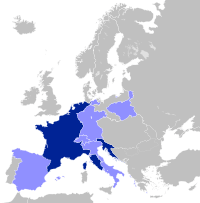Republic of Bergamo
The Republic of Bergamo or Repubblica Bergamasca was an ephemeral revolutionary client republic of 24 members, created on 13 March 1797, by the French army to rule the local administration of Bergamo and its province. With the Preliminary of Leoben, France and Austria agreed the end of the multi-centennial Venetian rule over the territory between Adda River and Oglio River, together with the Austrian occupation of Istria and Dalmatia.
Defined as "mother-municipality", the administration of the city of Bergamo had to help the creation of "dependent-municipalities" in all the surrounding county. The Republic so became one of the constituent countries of the Cisalpine Republic, established on 29 June 1797.
Establishment of the Revolutionary Republic
The French troops under General Bareguey entered Bergamo on Christmas Day of 1796, without a fight, according to the Venetian podestà, Count Ottolini, who had agreed to the withdrawal of the Venetian troops.
On 12 March 1797 was proclaimed the Republic of Bergamo. Ottolini, threatened with arrest, left for Brescia, while the new municipality was being elected, consisting of 24 persons, who also established a semblance of an army.
Two days later the Republic voted to be annected to the Republic Cispadana, and the symbols were removed from the doors of the Venetian Walls. The tree of liberty was erected in Piazza Vecchia, as well as in the districts.
The Constitution of 24 March
On 24 March the Constitution of the Republic of Bergamo was approved.
The new administration included the division of territory into cantons supra. Every territory that wanted to become a town, should have reunied its citizens in a church, under the authority of the priest, and they named a congressman. These, together with the other congressmen of the towns of Cantone, nominated three permanent members of the municipalities of the cantone. Once convened in Bergamo, they should indicate their acceptance of new administrative bodies, bringing the list of representatives of municipalities. The Municipality of Bergamo was formed by twenty-four states.
On 17 April 1797, wheat rallies general, men with power to vote in every church gathered to elect their representatives.
Subdivision of land
The republic was divided into 14 cantons, which were divided into towns:
- City of Bergamo
- Canton of Almenno
- Canton of Alzano
- Canton of Calepio
- Canton of Goat
- Canton of Clusone
- Canton Endine
- Canton of Gandino
- Canton of Martinengo or Bolgart; Calcinate; Cavernago; Cividate; Cortenuova; Fara Olivana; Ghisalba; Malpaga; Martinengo; Mornico; Palosco; Romano Telgate
- Canton Square
- Canton Bridge
- Canton of Seriate
- Canton of Verdello or Albegno; Arcene; Bariano; Bolton; Ciserano; Cologno; Colognola; New Comm; Curnasco; Grumello Plan; Lallio, Lift, Luray, Mariano, Morecambe; Osio Sopra, Osio Sotto; Pognano; Sabbio; Sforzatica; Sforzatica of Oleno ; Spirano; Stezzano, Trevor; Verdello Minor; Urgnano; Verdello
- Canton Vilminore
- Canton of Zogno
The counter-revolution in the valleys
In the valleys, and especially in Imagna Valley, however, took the form a sort of counter-revolution: the Republic appeared to be anti-religious, and especially in the countries of the charisma of the clergy could keep the population from the Venetians. The revolt was quelled, however, within a month
In this area also began to circulate the tale of the exploits of Pacì Paciana the brigand.
End self-experience
With the Treaty of Campo Formio, after about three months after its establishment, the Republic of Bergamo then entered a part of the Cisalpine Republic as Department of Serio.
Sources
Bortolo Belotti, Banca Popolare di Bergamo ,Storia di Bergamo e dei bergamaschi, Volume 6, Storia di Bergamo e dei bergamaschi Bortolo Belotti, Edizioni Bolis, 1989, the University of Virginia, 11 Mar
